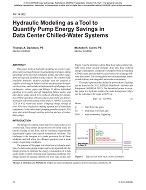A more recent period of weather data published in theASHRAE 2009 Handbook of Fundamentals was usedin developing ASHRAE Standard 169-2013. The newStandard remapped counties to climate zones based onthe new weather data. More than 400 counties out of atotal of over 3,000 in the U.S. were reassigned todifferent climate zones and most of the counties werereassigned to warmer climate zones. Many coderequirements, such as for wall insulation, are lessstringent in warmer climate zones. Thus, when a countyis reassigned to a warmer climate zone, new buildingsbuilt in that county are likely to be less energy efficientthan before. The new county-to-climate zone mappingin ASHRAE Standard 169-2013 has been adopted byStandard 90.1 and may be adopted by other codes andstandards as well. In this paper, we present the impactof changing the county-climate zone mapping onenergy codes and building energy efficiency in thecountry. The analysis shows that adopting the newcounty-to-climate zone mapping in ASHRAE Standard169-2013 results in an overall weakening of ASHRAEStandard 90.1-2013 at the national level while theimpacts at the state level can be dramatic, as there areseveral states where large population centers arereassigned to a warmer climate zone.
Citation: ASHRAE/IBPSA-USA Bldg Simulation Conf, 2016
Product Details
- Published:
- 2016
- Number of Pages:
- 8
- Units of Measure:
- Dual
- File Size:
- 1 file , 2.1 MB
- Product Code(s):
- D-BSC16-57


